What is in my crater?
As promised, I publish material about the place that is currently exploring the Curiosity rover. The crater of Gale and Mount Sharp (Aeolis), according to NASA, are the most promising objects for research on the surface of Mars. From there, we can get the richest scientific information that such a perfect robot geologist like Curiosity is able to gather.
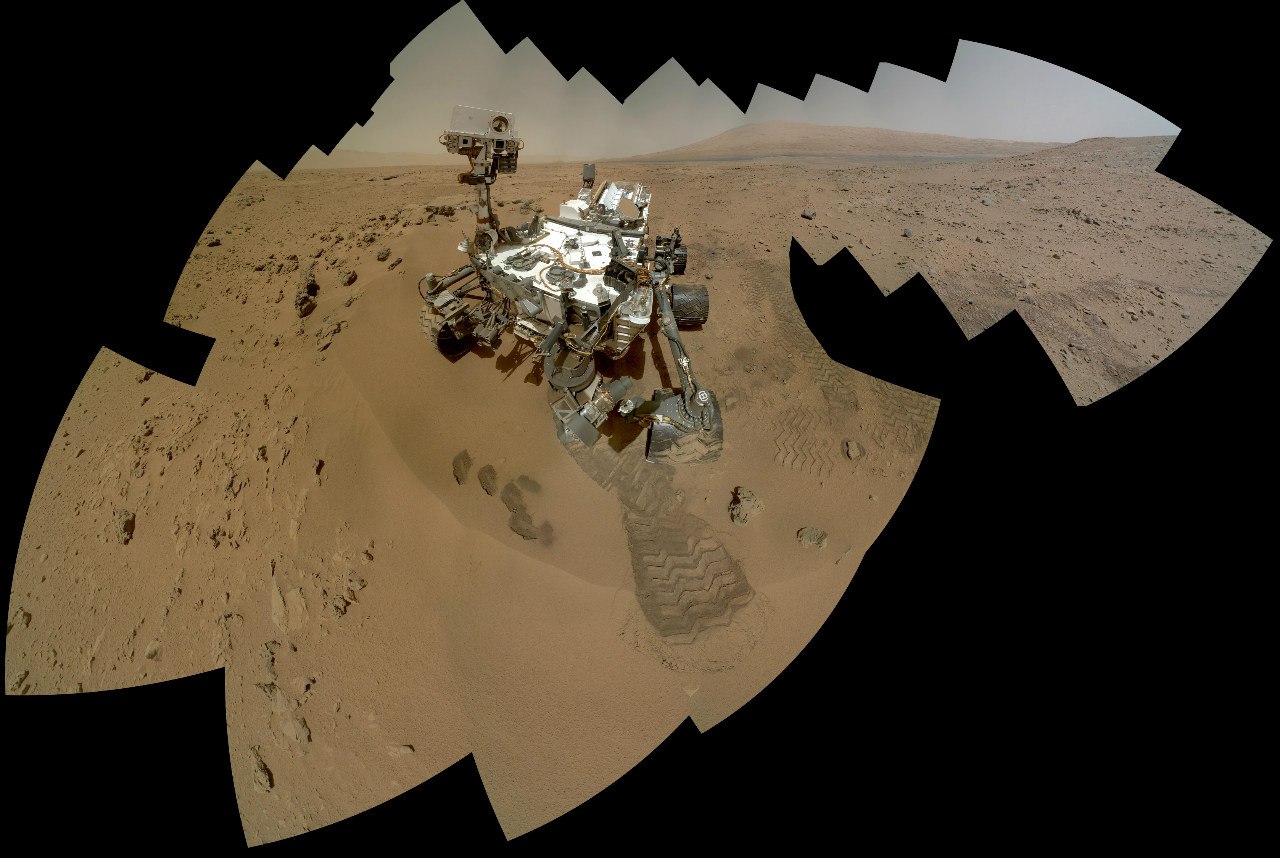
In order to choose a good place for research on Mars, it was necessary to properly study the planet from a distance - from orbit. To this end, in 2005, the Mars Reconnaissance Orbiter was launched - an outstanding device worthy of its land follower. This satellite is actually a telescope facing downwards, which has several cameras that allow you to shoot the surface of Mars with details up to 25 cm per pixel. It rotates in a circular orbit at an altitude of 300-275 km above the planet and incessantly scans the surface with its optical instruments.

Through the efforts of the MRO and its predecessors, several sites were identified that are of greatest interest for research and promise interesting discoveries. Almost all of them are related to the activity of water on the surface of Mars, and only Gale's crater with the mountain in the center is a more complex formation.
')
Mount Sharpe or officially “Eolid” is interesting at least because scientists all over the world simply cannot understand how it was formed. In addition to this riddle, Eolid is primarily attractive to scientists for its structure. Its layered structure is a unique outcrop, which is convenient for the study of available technical means. These factors determined the decision of NASA geologists, who after active discussions chose Gale crater as a target for MSL Curiosity.
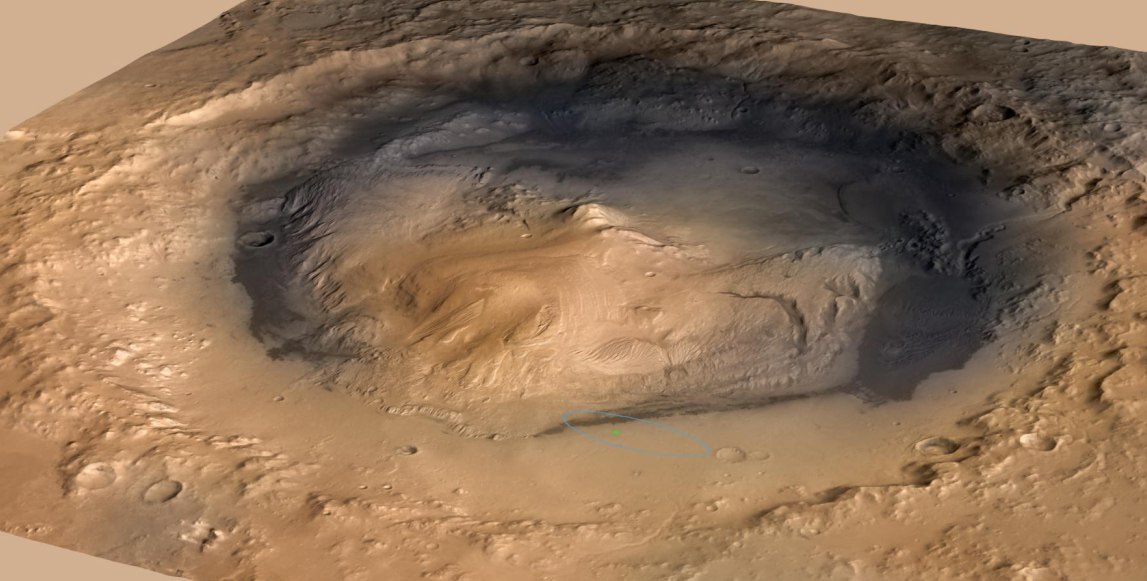
Gale's crater is a very ancient geological object on the surface of Mars. According to today's estimates, it is 3.5-3.8 billion years old. That is, it captures the most ancient - the Noachian (Noachian) period of the Martian geological history known today. Its first 100 thousand years old crater existed at a time when conditions on Mars were very similar to those of the Earth during the birth of the first life. It arose after the fall of a huge asteroid with a diameter of several kilometers. From the impact formed a 150-kilometer crater. The force of the explosion is comparable to the blow that killed dinosaurs on Earth 65 million years ago. Despite the scale of impact, this crater is not the largest on Mars. There are dozens like him, and record holders: Hellas, Argyr, Isidis - surpass Gale by ten or more times.
A feature of the formation of the Gale crater is a high central uplift. Such peaks are not uncommon in craters of this scale. Upon impact, the planetary crust behaves in almost the same way as the surface of a liquid when a drop falls, and the appearance of a central peak depends on the structure of the crust and the amount of energy released during the impact - the mountain will have time to harden or spread out, leaving the bottom of the crater flat.

Sharp’s mountain’s difference from other Martian craters is that it didn’t stand alone, but began to gather around itself a sedimentary “skirt” - layer after layer to creep away to the edge of the crater, but the deposits did not fill the crater along the very edges, leaving deep bottom.
After Gale's crater caught the attention of NASA, it was even more closely examined from orbit. Studies were conducted both in the optical range - with a HiRise MRO camera, and in the infrared. The analysis carried out by the Mars Odyssey satellite’s THEMIS camera made it possible to determine the geological differences in the structure of the soil, which looks monotonous for an ordinary human eye.
THEMIS allows you to identify differences in the Martian rock through the study of thermal inertia. In simple terms, the camera sees how quickly the surface cools after heating and how quickly it heats up after cooling. Depending on its geological structure, the surface behaves differently: the sand heats up quickly and cools quickly, the stone accumulates thermal energy for a long time and gives it away for a long time during the night. To determine the difference of heating-cooling, the survey was carried out in day and night mode.
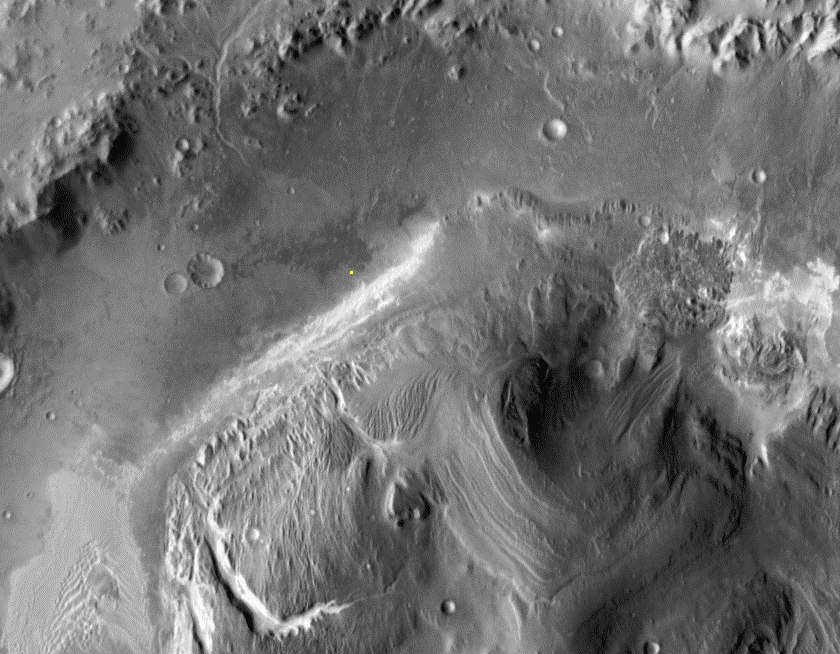
A similar device was installed on the Soviet apparatus "Phobos-2". Being engaged in the study of the behavior of the Martian soil under the shadow of Phobos, he managed to spawn a domestic ufological legend about the "spindle-shaped UFO" and the "wake of trace" on Mars. Although only removed the ground in the shade of Phobos with an infrared camera. Unfortunately, he worked for only a couple of months, and Mars Odyssey has been working for almost a decade, and after the recent “brain transplant” - the transition to a backup computer - it is still ready to work as much again.
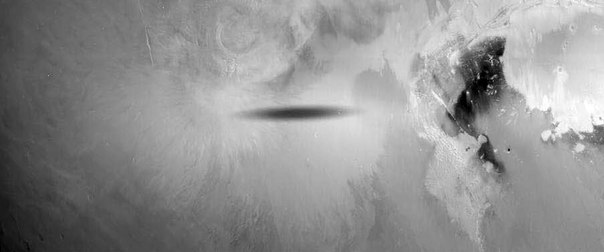
HiRise and THEMIS have determined the landing point in the Gale crater itself. Studying the Sharpe mountain in detail, the scientists discovered two deep canyons that cut the thickness of the mountain and created a convenient site for exploring its internal structure. Not far from one of them, thermal imaging identified another interesting part of the surface of Eolide Palls - the Eolide plain. A stream of water from the northwest washed away the ring shaft of the crater and brought out to the plain a fan (fan) of alluvial rocks. This fan has different characteristics of soil with low and high thermal inertia, that is, one part is loose, the second is very dense.
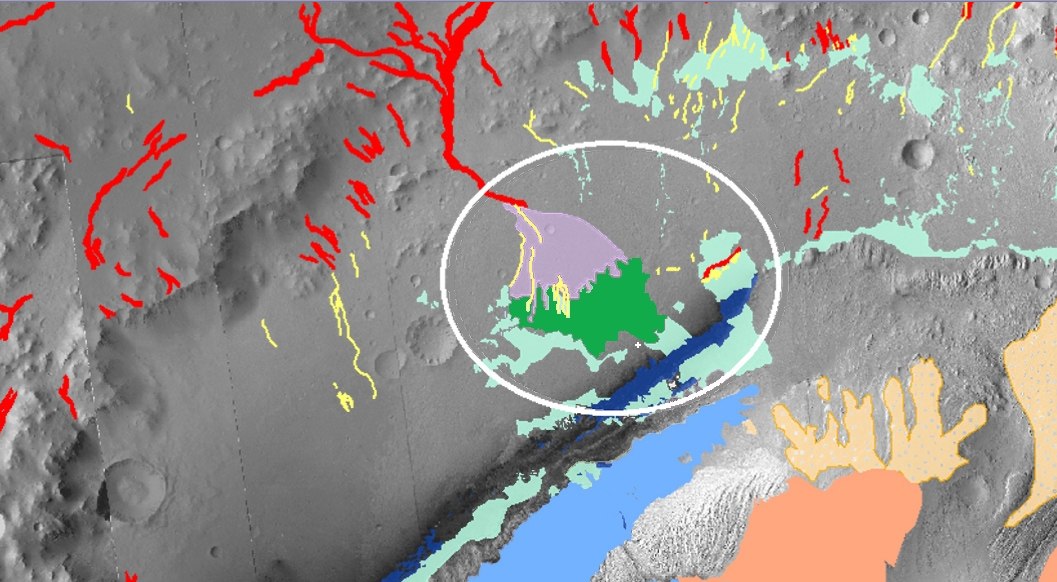
(Purple - friable deposits, green - hard. Red - canyon and river beds. The location of Curiosity is indicated by a white cross)
In addition, on the plain there are fairly common relief details for Mars, which are found not only in the Gale crater, but they have not yet been studied by land means. We are talking about inverted channels "on the contrary" (marked yellow in the diagram).

It is believed that this river channel, in which the soil has changed its structure and was stronger than the surrounding surface, which was destroyed by wind erosion. That is, the wind removed the river banks below their bottom, but bottom sediments turned out to be more resistant to weathering. An alternative theory of their formation suggests that inverted channels arose when river streams carried into standing water bodies. The streams slowed down and the sand, which carried water, fell to the bottom of lakes and seas. Similarly, river deltas are formed on Earth, and also formed on Mars, but there is no consensus about the emergence of inverted channels. Curiosity's work tools can help figure this out, but the rover landed away from these “channels” and is unlikely to make a detour of several kilometers for their sake.
Where the rover landed, the most attention of scientists chained to him a site with three types of soil.

The site, called Glenelg, was Curiosity's first major goal, which even forced him to deviate slightly from the original route. Three types of surface converge at this point: a cone with a low thermal inertia; the site, which NASA designates as HTI - high thermal inertia - with high thermal inertia; and more ancient site, densely covered with craters.
The study of the first type of soil took place on the way to Glenegl. It was here that the rounded pebbles were discovered, which indicated the effect of the flow of water.

A much greater interest of geologists is the HTI breed. Now this is the main mystery that Curiosity is going to figure out. Logically, high thermal inertia is characteristic of rocks, but this type of surface is located only in one place of the Gale crater - in the removal cone from the eroded wall of the crater. The original version of geologists was that this rock was washed out with water and cemented when the stream dried. The view from space suggested that such a scenario is quite plausible - the surface looks like the bottom of a dry lake, which is cracked. However, the rover looked at this place from below, and there is less hope that this surface is like dried mud.

Formats more VC
After Curiosity came out of the fan to Glenelg, more and more of its cameras began to record stones resembling volcanic rocks, and the rounded pebbles almost completely disappeared. At first, individual stones indicated their volcanic origin. The very first proven volcanic cobblestone - "Jake Matievich."

Then their number began to grow.
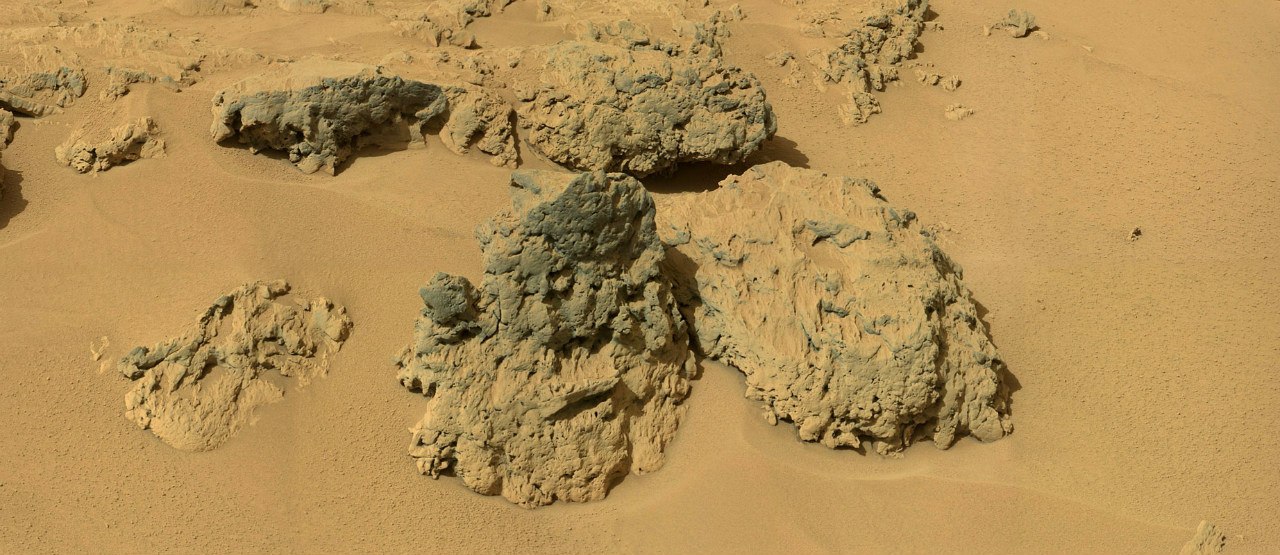
Finally, when some layers began to resemble whole frozen lava flows, I realized that it was time to look for a volcano.
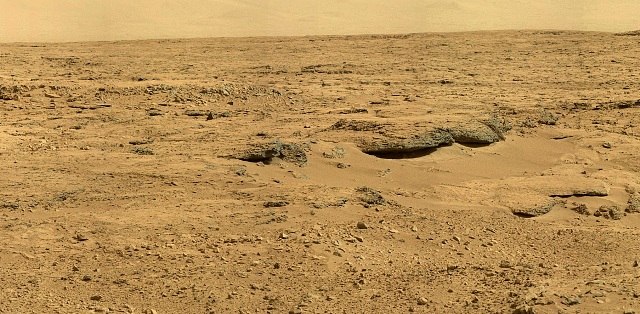
The nearest known volcano is in the Elysium Highlands, 1200 km from the Gale Crater. Some stones could somehow be thought of as having flown in during the most powerful eruptions. On Earth Krakatau scattered stones for hundreds of kilometers, and because of the low gravity on Mars, the range could increase several times. But it’s impossible to abandon the lava river so far, especially since it must still overcome the ring shaft of the crater. The conclusion was obvious: there was a volcano somewhere nearby. In this case, the likelihood that Mount Sharp - a volcano, almost zero. No signs of volcanic activity are visible from the satellite on the mountain itself. NASA does not mention anything about the volcano.
I had to arm myself with stereo glasses and go on a trip through an anaglyph snapshot of the crater and its surroundings.
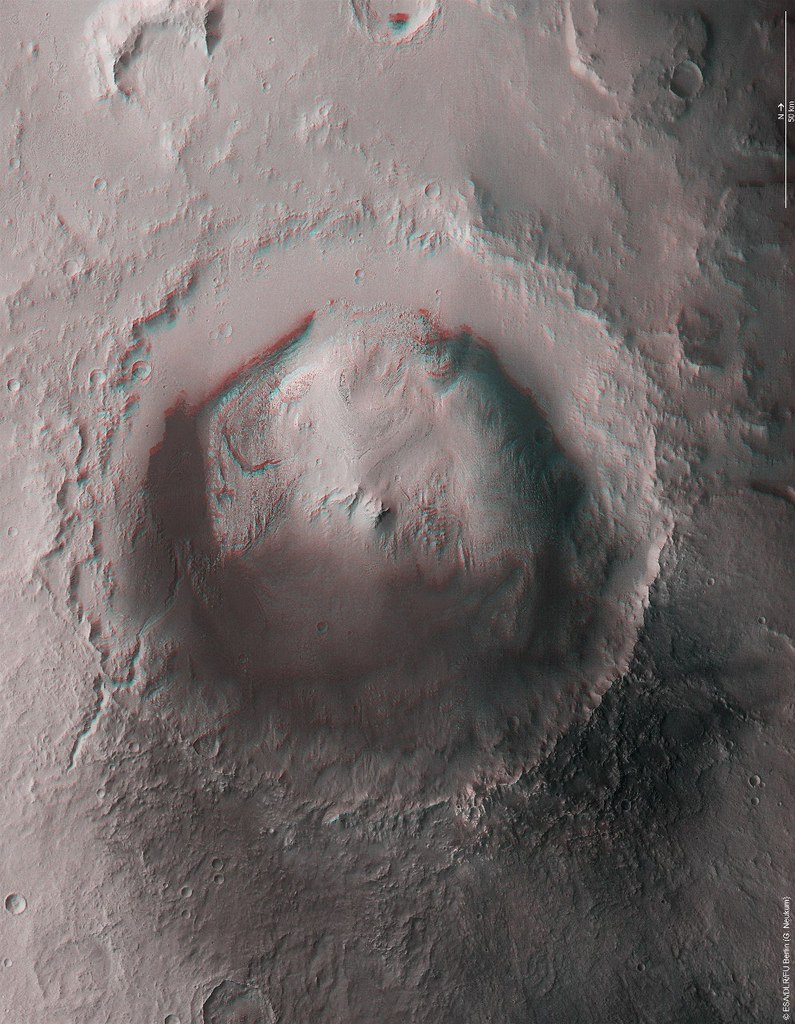
(NASA invites all owners of red-blue glasses to plunge into the world of Martian 3D anaglyphs)
And the volcano was found pretty quickly. More precisely, the mountain, which can be interpreted as a volcano. A crescent-shaped elevation can be found northwest of the landing site. Just there, from where flow of water flowed, cutting through the crater shaft and carrying the flow of rock to the plain.

The suggestion that this mountain is a volcano explains many observations. First, the river bed could have formed when eruptions led to the melting of glaciers, which could lie at the foot of the volcano. Secondly, all these pieces of pumice, volcanic tuff and lava accumulations around the rover are explained. Thirdly, it was lava that could be that hard rock with a high degree of thermal inertia. True, if you compare the thermal inertia map of rocks with the current location of the rover, you can see that it has not reached HTI yet, and there are already whole layers of lava around. So the final mystery is not solved.

(Red dots - route of the rover)
NASA, as it seems, does not even guess about this volcano, at least there is not a single mention in the scientific documentation describing the landing site, and there is not a single frame of this place by the high-resolution HiRise camera of the MRO satellite, of which Gail's crater and riverbed studied very closely.
But there are plenty of other mysteries in the crater. Two months ago, when Curiosity climbed into its stone nest (Rocknest) and spent 40 days in it, a very interesting section fell into the lenses of its cameras.

These layers, called Shaler, are located just on the border of two types of surface and can reveal the details of the origin of the oldest part of Glenelg. Typically, such sandstone layers are formed by seasonal exposure to water. Moreover, strictly horizontal layers - at the bottom of water bodies, and slanting - in the coastal zone - in fact, on the beaches.
Here, for example, the sandstone of Arizona:
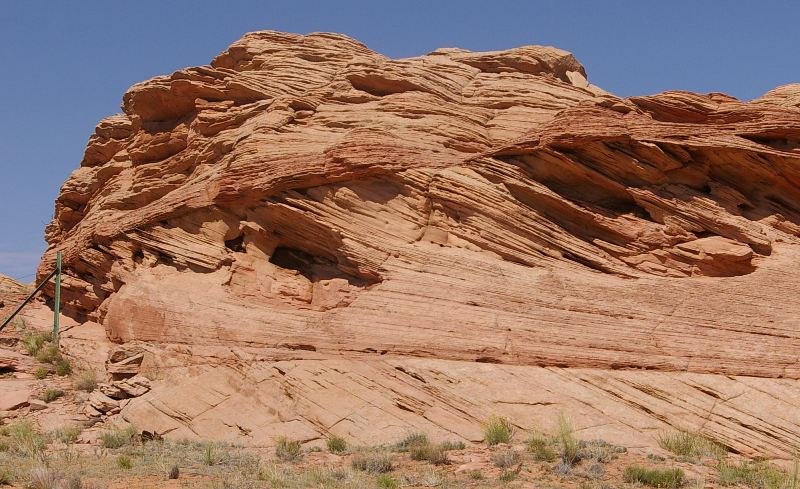
But the material of these Martian layers is not yet known; therefore, its other origin is also possible. The fact is that the rover is now deliberately moving to the point of Point Lake, where it is supposed to carry out the first drilling operations on Mars.

In his movement, he is only marginally distracted by interesting objects. Perhaps the Curiosity team intends to return by the same route, so it avoids even such attractive places as Shaler.
But the place is amazing. The name given in honor of the American paleontologist also hints at this. Obviously, NASA is waiting there for something interesting.
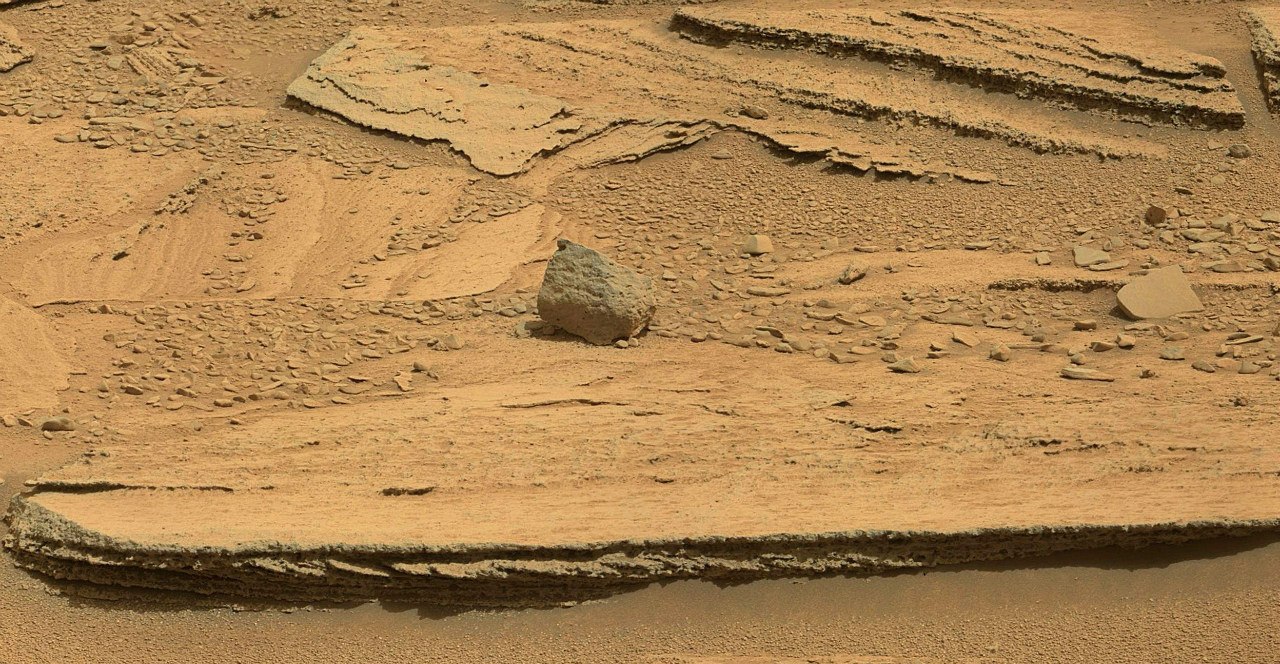
I look forward to when they return to the study of these layers.

As the descent to the lowland, called Yellowknifle Bay, strange “bubbles” began to fall under the wheels of the rover.

This is another mystery that NASA, to all appearances, has postponed until later, because during the whole race, attention has been paid practically to them. Only one of them was shot with a color camera, and it seems that not even a single one fired at the Chem Cam to find out the chemical composition. The fact that it is for the "bubbles", you can only speculate. If there are lava under the wheels, then there may be traces of fallen stones, which fell into a thickening stream and left such dents. If it is sandstone or other ancient sediments, then glandular nodules can be formed in this way.
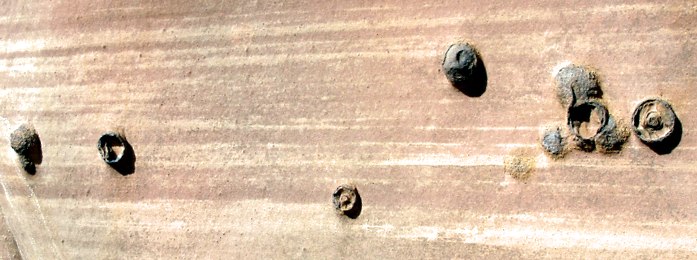
(This is a photo from Earth)
Given the recent excitement around the detection-detection of organic matter in Martian soil, we must tell you when we should expect a sensation. Volcanic rocks are not rich in organic matter even on Earth, especially organic matter of biological origin can not be there. Biological organics is also poorly preserved in alluvial sediments. The greatest hopes of NASA's astrobiologists, and indeed the entire world, are associated with one thin layer found in the Gale crater - phyllosilicates or smectites.

Practically only for their sake and equipped with a device SAM, capable of detecting organic matter of biological origin. Phyllosilicates are an ancient clay formed by water that eroded volcanic deposits in Noah time. This breed is widespread on Earth and very rare on Mars. The peculiarity of its formation is that water during this period was favorable for life, that is, it did not contain a large amount of sulphates and perchlorates, which poisoned it in the next geological epoch of the Hesperides.

Above this layer, sulphates are already coming, that is, climbing astrobiology from the point of view of astrobiology is not as interesting as the study of the foot. But having investigated these smectites, Curiosity will be able to give an almost definitive answer to the sacramental question - was there life on Mars or not. Here only he will reach them still not soon.

If the rover will move along the previously planned route, then it will travel about eight kilometers to the phyllosilicates. In the meantime, he has overcome about 500 meters, and almost in the opposite direction. After the geologists form a general idea of the structure of the plain, the movement of the rover will accelerate, but we will still have to wait at least 8-10 months to arrive at the foot of Mount Sharpe.

(Appeal to reposter: copyright is not important to me, but do not kill outgoing links, if I brought them, then I think that they are needed. Thank you.)

In order to choose a good place for research on Mars, it was necessary to properly study the planet from a distance - from orbit. To this end, in 2005, the Mars Reconnaissance Orbiter was launched - an outstanding device worthy of its land follower. This satellite is actually a telescope facing downwards, which has several cameras that allow you to shoot the surface of Mars with details up to 25 cm per pixel. It rotates in a circular orbit at an altitude of 300-275 km above the planet and incessantly scans the surface with its optical instruments.

Through the efforts of the MRO and its predecessors, several sites were identified that are of greatest interest for research and promise interesting discoveries. Almost all of them are related to the activity of water on the surface of Mars, and only Gale's crater with the mountain in the center is a more complex formation.
')
Mount Sharpe or officially “Eolid” is interesting at least because scientists all over the world simply cannot understand how it was formed. In addition to this riddle, Eolid is primarily attractive to scientists for its structure. Its layered structure is a unique outcrop, which is convenient for the study of available technical means. These factors determined the decision of NASA geologists, who after active discussions chose Gale crater as a target for MSL Curiosity.

Gale's crater is a very ancient geological object on the surface of Mars. According to today's estimates, it is 3.5-3.8 billion years old. That is, it captures the most ancient - the Noachian (Noachian) period of the Martian geological history known today. Its first 100 thousand years old crater existed at a time when conditions on Mars were very similar to those of the Earth during the birth of the first life. It arose after the fall of a huge asteroid with a diameter of several kilometers. From the impact formed a 150-kilometer crater. The force of the explosion is comparable to the blow that killed dinosaurs on Earth 65 million years ago. Despite the scale of impact, this crater is not the largest on Mars. There are dozens like him, and record holders: Hellas, Argyr, Isidis - surpass Gale by ten or more times.
A feature of the formation of the Gale crater is a high central uplift. Such peaks are not uncommon in craters of this scale. Upon impact, the planetary crust behaves in almost the same way as the surface of a liquid when a drop falls, and the appearance of a central peak depends on the structure of the crust and the amount of energy released during the impact - the mountain will have time to harden or spread out, leaving the bottom of the crater flat.

Sharp’s mountain’s difference from other Martian craters is that it didn’t stand alone, but began to gather around itself a sedimentary “skirt” - layer after layer to creep away to the edge of the crater, but the deposits did not fill the crater along the very edges, leaving deep bottom.
After Gale's crater caught the attention of NASA, it was even more closely examined from orbit. Studies were conducted both in the optical range - with a HiRise MRO camera, and in the infrared. The analysis carried out by the Mars Odyssey satellite’s THEMIS camera made it possible to determine the geological differences in the structure of the soil, which looks monotonous for an ordinary human eye.
THEMIS allows you to identify differences in the Martian rock through the study of thermal inertia. In simple terms, the camera sees how quickly the surface cools after heating and how quickly it heats up after cooling. Depending on its geological structure, the surface behaves differently: the sand heats up quickly and cools quickly, the stone accumulates thermal energy for a long time and gives it away for a long time during the night. To determine the difference of heating-cooling, the survey was carried out in day and night mode.

A similar device was installed on the Soviet apparatus "Phobos-2". Being engaged in the study of the behavior of the Martian soil under the shadow of Phobos, he managed to spawn a domestic ufological legend about the "spindle-shaped UFO" and the "wake of trace" on Mars. Although only removed the ground in the shade of Phobos with an infrared camera. Unfortunately, he worked for only a couple of months, and Mars Odyssey has been working for almost a decade, and after the recent “brain transplant” - the transition to a backup computer - it is still ready to work as much again.

HiRise and THEMIS have determined the landing point in the Gale crater itself. Studying the Sharpe mountain in detail, the scientists discovered two deep canyons that cut the thickness of the mountain and created a convenient site for exploring its internal structure. Not far from one of them, thermal imaging identified another interesting part of the surface of Eolide Palls - the Eolide plain. A stream of water from the northwest washed away the ring shaft of the crater and brought out to the plain a fan (fan) of alluvial rocks. This fan has different characteristics of soil with low and high thermal inertia, that is, one part is loose, the second is very dense.

(Purple - friable deposits, green - hard. Red - canyon and river beds. The location of Curiosity is indicated by a white cross)
In addition, on the plain there are fairly common relief details for Mars, which are found not only in the Gale crater, but they have not yet been studied by land means. We are talking about inverted channels "on the contrary" (marked yellow in the diagram).

It is believed that this river channel, in which the soil has changed its structure and was stronger than the surrounding surface, which was destroyed by wind erosion. That is, the wind removed the river banks below their bottom, but bottom sediments turned out to be more resistant to weathering. An alternative theory of their formation suggests that inverted channels arose when river streams carried into standing water bodies. The streams slowed down and the sand, which carried water, fell to the bottom of lakes and seas. Similarly, river deltas are formed on Earth, and also formed on Mars, but there is no consensus about the emergence of inverted channels. Curiosity's work tools can help figure this out, but the rover landed away from these “channels” and is unlikely to make a detour of several kilometers for their sake.
Where the rover landed, the most attention of scientists chained to him a site with three types of soil.

The site, called Glenelg, was Curiosity's first major goal, which even forced him to deviate slightly from the original route. Three types of surface converge at this point: a cone with a low thermal inertia; the site, which NASA designates as HTI - high thermal inertia - with high thermal inertia; and more ancient site, densely covered with craters.
The study of the first type of soil took place on the way to Glenegl. It was here that the rounded pebbles were discovered, which indicated the effect of the flow of water.

A much greater interest of geologists is the HTI breed. Now this is the main mystery that Curiosity is going to figure out. Logically, high thermal inertia is characteristic of rocks, but this type of surface is located only in one place of the Gale crater - in the removal cone from the eroded wall of the crater. The original version of geologists was that this rock was washed out with water and cemented when the stream dried. The view from space suggested that such a scenario is quite plausible - the surface looks like the bottom of a dry lake, which is cracked. However, the rover looked at this place from below, and there is less hope that this surface is like dried mud.

Formats more VC
After Curiosity came out of the fan to Glenelg, more and more of its cameras began to record stones resembling volcanic rocks, and the rounded pebbles almost completely disappeared. At first, individual stones indicated their volcanic origin. The very first proven volcanic cobblestone - "Jake Matievich."

Then their number began to grow.

Finally, when some layers began to resemble whole frozen lava flows, I realized that it was time to look for a volcano.

The nearest known volcano is in the Elysium Highlands, 1200 km from the Gale Crater. Some stones could somehow be thought of as having flown in during the most powerful eruptions. On Earth Krakatau scattered stones for hundreds of kilometers, and because of the low gravity on Mars, the range could increase several times. But it’s impossible to abandon the lava river so far, especially since it must still overcome the ring shaft of the crater. The conclusion was obvious: there was a volcano somewhere nearby. In this case, the likelihood that Mount Sharp - a volcano, almost zero. No signs of volcanic activity are visible from the satellite on the mountain itself. NASA does not mention anything about the volcano.
I had to arm myself with stereo glasses and go on a trip through an anaglyph snapshot of the crater and its surroundings.

(NASA invites all owners of red-blue glasses to plunge into the world of Martian 3D anaglyphs)
And the volcano was found pretty quickly. More precisely, the mountain, which can be interpreted as a volcano. A crescent-shaped elevation can be found northwest of the landing site. Just there, from where flow of water flowed, cutting through the crater shaft and carrying the flow of rock to the plain.

The suggestion that this mountain is a volcano explains many observations. First, the river bed could have formed when eruptions led to the melting of glaciers, which could lie at the foot of the volcano. Secondly, all these pieces of pumice, volcanic tuff and lava accumulations around the rover are explained. Thirdly, it was lava that could be that hard rock with a high degree of thermal inertia. True, if you compare the thermal inertia map of rocks with the current location of the rover, you can see that it has not reached HTI yet, and there are already whole layers of lava around. So the final mystery is not solved.

(Red dots - route of the rover)
NASA, as it seems, does not even guess about this volcano, at least there is not a single mention in the scientific documentation describing the landing site, and there is not a single frame of this place by the high-resolution HiRise camera of the MRO satellite, of which Gail's crater and riverbed studied very closely.
But there are plenty of other mysteries in the crater. Two months ago, when Curiosity climbed into its stone nest (Rocknest) and spent 40 days in it, a very interesting section fell into the lenses of its cameras.

These layers, called Shaler, are located just on the border of two types of surface and can reveal the details of the origin of the oldest part of Glenelg. Typically, such sandstone layers are formed by seasonal exposure to water. Moreover, strictly horizontal layers - at the bottom of water bodies, and slanting - in the coastal zone - in fact, on the beaches.
Here, for example, the sandstone of Arizona:

But the material of these Martian layers is not yet known; therefore, its other origin is also possible. The fact is that the rover is now deliberately moving to the point of Point Lake, where it is supposed to carry out the first drilling operations on Mars.

In his movement, he is only marginally distracted by interesting objects. Perhaps the Curiosity team intends to return by the same route, so it avoids even such attractive places as Shaler.
But the place is amazing. The name given in honor of the American paleontologist also hints at this. Obviously, NASA is waiting there for something interesting.

I look forward to when they return to the study of these layers.

As the descent to the lowland, called Yellowknifle Bay, strange “bubbles” began to fall under the wheels of the rover.

This is another mystery that NASA, to all appearances, has postponed until later, because during the whole race, attention has been paid practically to them. Only one of them was shot with a color camera, and it seems that not even a single one fired at the Chem Cam to find out the chemical composition. The fact that it is for the "bubbles", you can only speculate. If there are lava under the wheels, then there may be traces of fallen stones, which fell into a thickening stream and left such dents. If it is sandstone or other ancient sediments, then glandular nodules can be formed in this way.

(This is a photo from Earth)
Given the recent excitement around the detection-detection of organic matter in Martian soil, we must tell you when we should expect a sensation. Volcanic rocks are not rich in organic matter even on Earth, especially organic matter of biological origin can not be there. Biological organics is also poorly preserved in alluvial sediments. The greatest hopes of NASA's astrobiologists, and indeed the entire world, are associated with one thin layer found in the Gale crater - phyllosilicates or smectites.

Practically only for their sake and equipped with a device SAM, capable of detecting organic matter of biological origin. Phyllosilicates are an ancient clay formed by water that eroded volcanic deposits in Noah time. This breed is widespread on Earth and very rare on Mars. The peculiarity of its formation is that water during this period was favorable for life, that is, it did not contain a large amount of sulphates and perchlorates, which poisoned it in the next geological epoch of the Hesperides.

Above this layer, sulphates are already coming, that is, climbing astrobiology from the point of view of astrobiology is not as interesting as the study of the foot. But having investigated these smectites, Curiosity will be able to give an almost definitive answer to the sacramental question - was there life on Mars or not. Here only he will reach them still not soon.

If the rover will move along the previously planned route, then it will travel about eight kilometers to the phyllosilicates. In the meantime, he has overcome about 500 meters, and almost in the opposite direction. After the geologists form a general idea of the structure of the plain, the movement of the rover will accelerate, but we will still have to wait at least 8-10 months to arrive at the foot of Mount Sharpe.

(Appeal to reposter: copyright is not important to me, but do not kill outgoing links, if I brought them, then I think that they are needed. Thank you.)
Source: https://habr.com/ru/post/162567/
All Articles